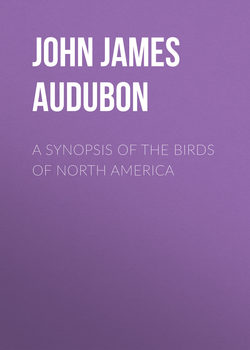Читать книгу A Synopsis of the Birds of North America - John James Audubon - Страница 18
FAMILY III. STRIGINÆ. OWLS
GENUS III. STRIX, Linn. SCREECH-OWL
ОглавлениеBill short, compressed, deep, strong; upper mandible with its dorsal outline straight to the end of the cere, then curved, the sides nearly flat and erect, the tip deflected, with a rounded but sharp-edged point; lower mandible with the dorsal line convex, the sides convex, the edges arched, the tip obliquely truncate. Conch of the ear semicircular, extending from over the anterior angle of the eye to the middle of the lower jaw; aperture large, somewhat square, with an anterior operculum fringed with feathers. Legs rather long, tarsus long, feathered, scaly at the lower part; toes large, the first short, the inner nearly as long as the middle, all with series of small tuberculiform oblong scales, intermixed with a few bristles, and three broad scutella at the end. Claws arched, long, extremely sharp, the edge of the third thin and transversely cracked in old birds. Plumage very soft and downy; facial disks complete. Wings long, ample, rounded; the first quill with the filaments recurved. Tail rather short, even.
34. 1. Strix Americana, Aud. American Screech-Owl. – Barn Owl
Plate CLXXI. Male and Female.
Feathers margining the operculum with the shaft and webs undeveloped. Bill pale greyish-yellow; claws and scales brownish-yellow. General colour of upper parts greyish-brown, with light yellowish-red interspersed, produced by very minute mottling; each feather having toward the end a central streak of deep brown, terminated by a small oblong greyish-white spot; wings similarly coloured; secondary coverts and outer edges of primary coverts with a large proportion of light brownish-red; quills and tail transversely barred with brown; lower parts pale brownish-red, fading anteriorly into white, each feather having a small dark brown spot at the tip.
Closely allied to Strix flammea, but larger, and differing somewhat in colour, being generally darker, with the ruff red. A character by which they may always be distinguished is found in the operculum, the feathers margining which are in the present species reduced to their tubes, the shafts and filaments being wanting, whereas in the European species each tube bears a very slender shaft, about half an inch long, and furnished with about half a dozen filaments on each side.
Male, 17, 42. Female, 18, 46.
Southern States. Breeds from Texas to North Carolina. Never seen in the interior, or to the north. Rather common.
White or Barn Owl, Strix flammea, Wils. Amer. Orn. v. vi. p. 57.
Strix flammea, Bonap. Synops. p. 38.
White or Barn Owl, Strix flammea, Nutt. Man. v. i. p. 139.
Barn Owl, Strix flammea, Aud. Orn. Biog. v. ii. p. 403: v. v. p. 388.
